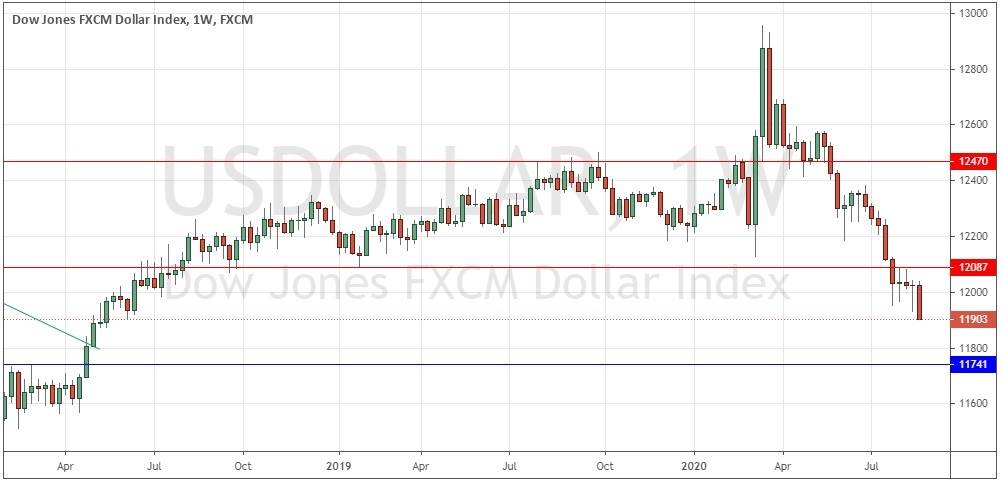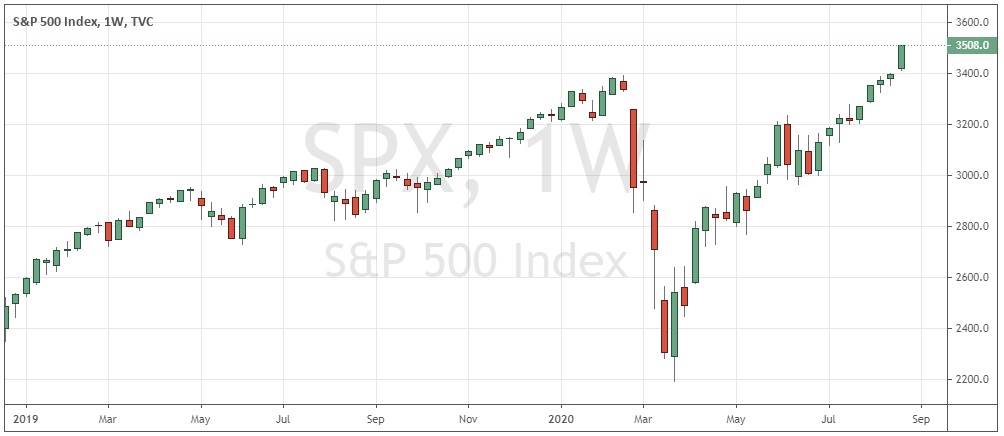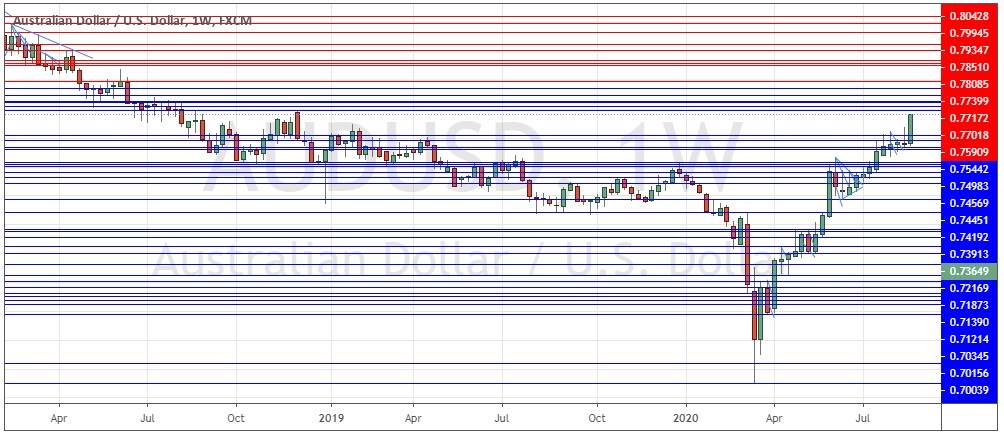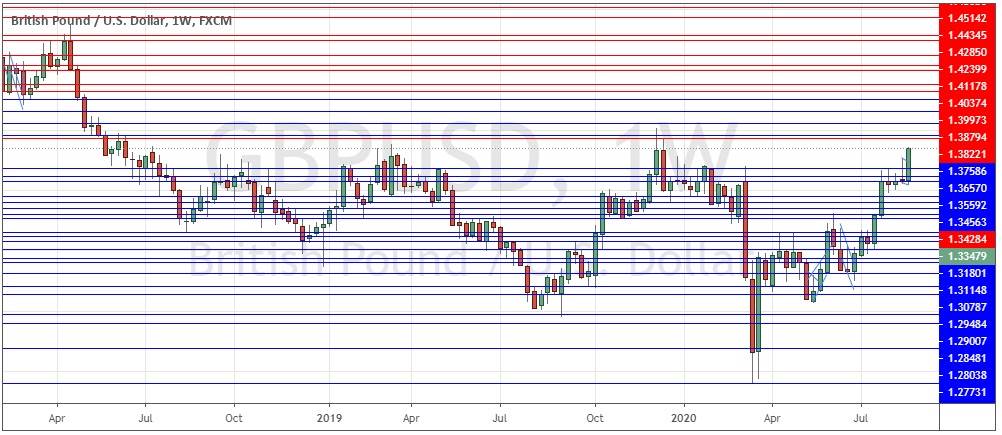The difference between success and failure in Forex trading is very likely to depend mostly upon which currency pairs you choose to trade each week, and not on the exact trading methods you might use to determine trade entries and exits. The current market environment has changed from one of crisis to a seemingly strong rebound as global stock market indices begin to reach new all-time highs, despite the continuing growth in the coronavirus pandemic which is still sweeping the world.
Big Picture 30th August 2020
In my previous piece last week, I saw the most attractive trade set-up as likely to be long of the S&P 500 Index. This was a great call as the major U.S. stock index rose over the week by 2.63%.
Last week’s Forex market saw the strongest rise in the relative value of the Australian Dollar and the strongest fall in the relative value of the U.S. Dollar.
Fundamental Analysis & Market Sentiment
The economic impact of the coronavirus pandemic seems to be transferring income streams from smaller to larger businesses and boosting the profitability of large tech companies.
The market’s focus now is centered on the political dispute in the U.S.A. over the terms of additional fiscal stimulus which the U.S. economy is seen to require as the U.S. economic recovery is endangered by the resurgent coronavirus. This is echoed in other countries around the world, with markets watching to see how effectively local economies bounce back from the initial part of the crisis.
Another area of focus is the U.S. Federal Reserve’s indication that it will no longer treat strong employment data as a reason to raise rates. This had the effect of boosting stocks and other risky assets and continuing the long-term trend of a weaker U.S. Dollar.
The third major issue now is progress being made in a number of channels towards a safe and effective coronavirus vaccine. A related issue here that saw a major development over the past week is the announcement by Abbot Laboratories that they will be rolling out 50 million units from October of a very cheap and accurate home coronavirus test every month. If well used, this tool could enable severe containment or even localized eradication of the virus.
Last week again saw the number of confirmed new coronavirus cases fail to exceed the daily all-time high which was made at the end of July. This is a sign that globally, this wave of the disease may have already peaked.
We have seen the epicenter of the global coronavirus pandemic move into Latin America, although the U.S.A. is still recording more new daily deaths from the virus than any other country. The number of new cases in the U.S.A. has declined notably in recent days. Globally, coronavirus deaths are still lower than they were during their peak in early April, suggesting the virus may have become less lethal, or medical systems are improving their treatment capacities. However, a worrying development has come in the form of a strong rise in new daily cases within the European Union over recent days.
Latin America and the Caribbean are now responsible for approximately 45% of confirmed new daily deaths, with the U.S.A. at 17% and Europe at about 6%. The strongest growth in new confirmed cases is happening in Argentina, Austria, Bahamas, Belize, Bosnia, Brazil, Bulgaria, Burma, Colombia, Costa Rica, Croatia, Czech Republic, Ecuador, Ethiopia, France, Germany, Greece, Guatemala, Honduras, Hungary, India, Indonesia, Iraq, Israel, Italy, Jamaica, Jordan, Kuwait, Lebanon, Lithuania, Malta, Mexico, Moldova, Montenegro, Morocco, Nepal, Paraguay, Poland, Portugal, Romania, Slovakia, Slovenia, South Korea, Spain, Sweden, Switzerland, Trinidad, Tunisia, Turkey, U.A.E., Ukraine, the United Kingdom, and Venezuela.
The U.S. stock market rose again by more than 2% last week to make its highest all-time weekly close, with the MSCI World Index also making a new all-time high. Typically, such new all-time highs tend to produce further rises of 9% on average over the next year or so, suggesting the stock market is likely to continue to advance. Despite these high prices, analysts tend to be concerned about the persistence of unemployment from earlier closures and restrictions and the economic impact of the reversals of easing which have been imposed in several states. However, the U.S. market still hopes to see an additional and far-reaching stimulus package from the federal government soon, despite the current political impasse.
The U.S. Federal Reserve made comments last week which many analysts saw as dovish for the U.S. Dollar. The U.S. Dollar Index fell last week against almost every “risk” asset such as stocks and most other major currencies, notably the Australian and New Zealand Dollars, as well as the British Pound.
The European economic recovery still seems to be in relatively good shape although there are worrying signs that the coronavirus is coming back strongly within the E.U. especially in France, Spain, and Germany. Nevertheless, this macro environment has helped to boost the Euro.
There is an increased feeling that the Eurozone economy may be better placed to recover from the economic impact of the coronavirus than the U.S. economy, which has helped boost the Euro against the U.S. Dollar. The Canadian Dollar has also been strong, boosted by the recovery of the price of Crude Oil as a major oil producer.
The coming week is likely to bring a more active Forex market as the August holiday season comes to an end and we await important non-farm payrolls data from the U.S. as well as key numbers concerning Australia and Canada.
Technical Analysis
U.S. Dollar Index
The weekly price chart below shows last week printed a firmly bearish candlestick which ended the week at a new 2-year low closing price. The candlestick closed right on its low, which is a bearish sign. There is a long-term bearish trend, as the price is lower than it was both 3 and 6 months ago. Overall, next week’s price movement in the U.S. Dollar looks very likely to again be downwards.
S&P 500 Index
Last week printed a large bullish candlestick, which closed right at the high of its range at a new all-time high weekly closing price. This is a very bullish sign and usually new all-time highs signal that the price is going to rise further over the coming weeks and months. The range of the weekly candlestick was also larger than has been seen for approximately the last 2 months which is another bullish sign. The NASDAQ 100 technology index also closed at a strong new all-time high, and stocks globally also made a new high as measured by the MSCI World Index. Stock markets and this index in particular are likely to rise higher over the coming week.
AUD/USD
The Australian Dollar is in a long-term bullish trend and rose again strongly last week against the U.S. Dollar which is in a long-term bearish trend. The “Aussie” has shown great strength as the premier “risk” currency in the Forex market, and we are again seeing strong bullish momentum in this multi-month rise as the price ended last week at a 2-year high closing price, which is another bullish sign.
GBP/USD
The British Pound Dollar is in a long-term bullish trend which strengthened sharply at the end of last week against the U.S. Dollar, which is in a long-term bearish trend. The Pound is strengthening as are almost all “risk” currencies in the Forex market, and we are again seeing strong bullish momentum in this multi-month rise as the price ended last week at a 2-year high closing price, which is another bullish sign.
Bottom Line
I see the most attractive trade set-up for this week as likely to be long of the S&P 500 Index and the AUD/USD and GBP/USD currency pairs.





